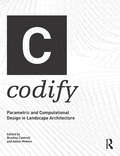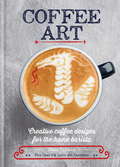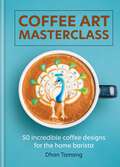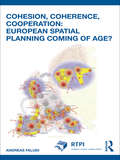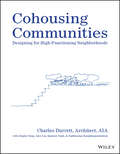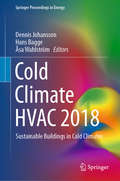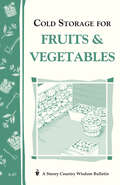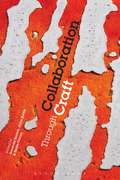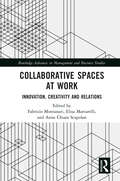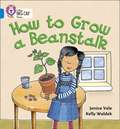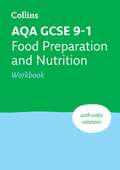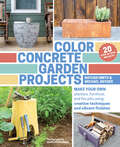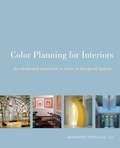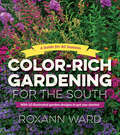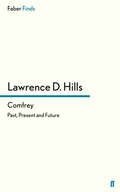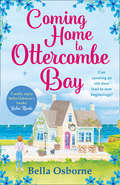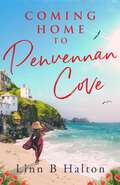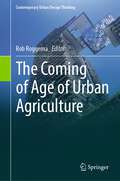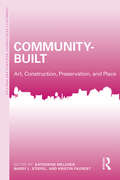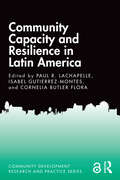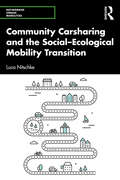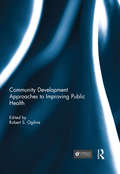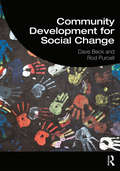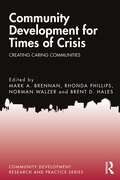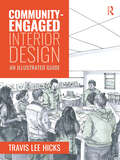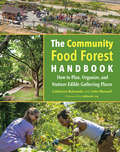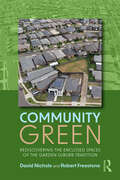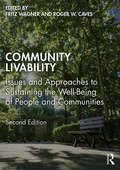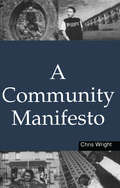- Table View
- List View
Codify: Parametric and Computational Design in Landscape Architecture
by Bradley Cantrell Adam MekiesCodify: Parametric and Computational Design in Landscape Architecture provides a series of essays that explore what it means to use, modify and create computational tools in a contemporary design environment. Landscape architecture has a long history of innovation in the areas of computation and media, particularly in how the discipline represents, analyses, and constructs complex systems. This curated volume spans academic and professional projects to form a snapshot of digital practices that aim to show how computation is a tool that goes beyond methods of representation and media. The book is organized in four sections; syntax, perception, employ, and prospective. The essays are written by leading academics and professionals and the sections examine the role of computational tools in landscape architecture through case studies, historical accounts, theoretical arguments, and nascent propositions.
Codify: Parametric and Computational Design in Landscape Architecture
by Bradley Cantrell Adam MekiesCodify: Parametric and Computational Design in Landscape Architecture provides a series of essays that explore what it means to use, modify and create computational tools in a contemporary design environment. Landscape architecture has a long history of innovation in the areas of computation and media, particularly in how the discipline represents, analyses, and constructs complex systems. This curated volume spans academic and professional projects to form a snapshot of digital practices that aim to show how computation is a tool that goes beyond methods of representation and media. The book is organized in four sections; syntax, perception, employ, and prospective. The essays are written by leading academics and professionals and the sections examine the role of computational tools in landscape architecture through case studies, historical accounts, theoretical arguments, and nascent propositions.
Coffee Art: Creative Coffee Designs for the Home Barista
by Dhan TamangOver 128 pages of 60 stunning designs from Britain's champion latte artist. From free pouring to etching, stencilling and more complicated designs for the black belt barista, you'll have fun emulating innovative designs such as The Swan, The Unicorn, and frothy 3-D babyccino animals. The book even includes 9 stencil patterns for you to trace and try.Starting with basic skills and patterns, readers will learn how to create the crema (the froth that acts as a canvas in the coffee cup) and how to produce the hearts, rosettas and tulips that will be used as the basis to form more complicated artworks. Dhan Tamang is a world-renowned latte artist particularly known for his use of colour, and now you too can create impressive multicoloured designs following Dhan's step-by-step instructions. By the end of this book you will be able to create fabulous designs to delight family members and dinner party guests alike.
Coffee Art Masterclass: 50 incredible coffee designs for the home barista
by Dhan TamangTake your coffee art to the next level with 50 spectacular-yet-simple latte art designs to impress family and friends. From the comfort of your own kitchen you can recreate great paintings, pour and etch stunning natural wonders, iconic buildings and fantastical creatures. No special equipment is needed and once you've mastered the basics a world of incredible coffee art awaits you.Coffee Art Masterclass includes next-level latte designs that everyone can achieve.
Cohesion, Coherence, Cooperation: European Spatial Planning Coming of Age? (RTPI Library Series)
by Andreas FaludiSince its foundation the European Union has gradually developed policies that are aimed at achieving increased economic and social cohesion. This book examines the most recent of these, the concept of territorial cohesion. Territorial cohesion is the pursuit of balanced development, competitiveness, sustainable development, and good governance. These concerns are most readily addressed by the formulation of spatial strategies under the umbrella of spatial planning, that brings together a multitude of public and private actors in a process that requires cohesion, coherence and co-operation. This book traces the development of spatial planning at European level and argues that spatial planning can become a vehicle, not only for territorial cohesion, but for EU policy generally.
Cohesion, Coherence, Cooperation: European Spatial Planning Coming of Age? (RTPI Library Series)
by Andreas FaludiSince its foundation the European Union has gradually developed policies that are aimed at achieving increased economic and social cohesion. This book examines the most recent of these, the concept of territorial cohesion. Territorial cohesion is the pursuit of balanced development, competitiveness, sustainable development, and good governance. These concerns are most readily addressed by the formulation of spatial strategies under the umbrella of spatial planning, that brings together a multitude of public and private actors in a process that requires cohesion, coherence and co-operation. This book traces the development of spatial planning at European level and argues that spatial planning can become a vehicle, not only for territorial cohesion, but for EU policy generally.
Cohousing Communities: Designing for High-Functioning Neighborhoods
by Charles DurrettCohousing Communities Explore a groundbreaking and holistic new approach to designing community-first neighborhoods In Cohousing Communities: Designing for High-Functioning Neighborhoods, distinguished architect and affordable housing advocate Charles Durrett delivers a complete, start-to-finish guide for designing anything where the emphasis lies with the community. This book describes the consequential role that architecture and a healthy design process can play in the success of neighborhoods, churches, towns, and more. It’s an inspiring collection of ideas that prioritize high-functioning neighborhoods. In the book, the author draws on the success of hundreds of community-first projects to show readers how to design a project that addresses both timeless and modern challenges—from aging to climate change and racism—in its architecture and urban design. He compiles facts and concepts that are essential to the design of a high-functioning community, where people can participate in a way that reflects their values, improves their social connections, and retain their autonomy and privacy. Readers will also find: Ideas for town planning, street planning, and other town altering improvements Discussions of how developers can make better multifamily housing Explorations of how planners and politicians can make high-functioning neighborhoods a cornerstone of their community In-depth treatments of families who want to confirm that they’re choosing the right neighborhood Perfect for university students and professors who strive to see new ways to create neighborhoods, Cohousing Communities: Designing for High-Functioning Neighborhoods will also appeal to universities planning new neighborhoods for retired alumni or new housing for students and faculty.
Cohousing Communities: Designing for High-Functioning Neighborhoods
by Charles DurrettCohousing Communities Explore a groundbreaking and holistic new approach to designing community-first neighborhoods In Cohousing Communities: Designing for High-Functioning Neighborhoods, distinguished architect and affordable housing advocate Charles Durrett delivers a complete, start-to-finish guide for designing anything where the emphasis lies with the community. This book describes the consequential role that architecture and a healthy design process can play in the success of neighborhoods, churches, towns, and more. It’s an inspiring collection of ideas that prioritize high-functioning neighborhoods. In the book, the author draws on the success of hundreds of community-first projects to show readers how to design a project that addresses both timeless and modern challenges—from aging to climate change and racism—in its architecture and urban design. He compiles facts and concepts that are essential to the design of a high-functioning community, where people can participate in a way that reflects their values, improves their social connections, and retain their autonomy and privacy. Readers will also find: Ideas for town planning, street planning, and other town altering improvements Discussions of how developers can make better multifamily housing Explorations of how planners and politicians can make high-functioning neighborhoods a cornerstone of their community In-depth treatments of families who want to confirm that they’re choosing the right neighborhood Perfect for university students and professors who strive to see new ways to create neighborhoods, Cohousing Communities: Designing for High-Functioning Neighborhoods will also appeal to universities planning new neighborhoods for retired alumni or new housing for students and faculty.
Cold Climate HVAC 2018: Sustainable Buildings In Cold Climates (Springer Proceedings in Energy)
by Dennis Johansson Hans Bagge Åsa WahlströmThis volume presents the proceedings of the 9th Cold Climate HVAC conference, which was held in Kiruna, Sweden in 2018. The conference highlighted key technologies and processes that allow scientists, designers, engineers, manufacturers and other decision makers in cold climate regions to achieve good indoor environmental quality (IEQ) with a minimum use of energy and other resources. The conference addressed various technical, economic and social aspects of buildings and HVAC systems in new and renovated buildings. This proceedings volume gathers peer-reviewed papers by a diverse and international range of authors and showcases perspectives and practices in cold climate building design from around the globe. The following major aspects, which include both fundamental and theoretical research as well as applications and case studies, are covered: (1) Energy and power efficiency and low-energy buildings; (2) Renovating buildings; (3) Efficient HVAC components; (4) Heat pumps and geothermal systems; (5) Municipal and city energy systems; (6) Construction management; (7) Buildings in operation; (8) Building simulation; (9) Reference data; (10) Transdisciplinary connections and social aspects; (11) Indoor environments and health; (12) Moisture safety and water damage; (13) Codes, regulations, standards and policies; and (14) Other aspects of buildings in cold climates.
Cold Storage for Fruits & Vegetables: Storey Country Wisdom Bulletin A-87 (Storey Country Wisdom Bulletin)
by John Storey Martha StoreySince 1973, Storey's Country Wisdom Bulletins have offered practical, hands-on instructions designed to help readers master dozens of country living skills quickly and easily. There are now more than 170 titles in this series, and their remarkable popularity reflects the common desire of country and city dwellers alike to cultivate personal independence in everyday life.
Collaboration Through Craft
by Amanda Ravetz Alice Kettle Helen FelceyOffering a challenging new argument for the collaborative power of craft, this ground-breaking volume analyses the philosophies, politics and practicalities of collaborative craft work. The book is accessibly organised into four sections covering the cooperation and compromises required by the collaborative process; the potential of recent technological advances for the field of craft; the implications of cross-disciplinary and cross-cultural collaborations for authority and ownership; and the impact of crafted collaborations on the institutions where we work, learn and teach. With cutting-edge essays by established makers and artists such as Allison Smith (US) and Brass Art (UK), curator Lesley Millar, textile designer Trish Belford and distinguished thinker Glenn Adamson, Collaborating Through Craft will be essential reading for students, artists, makers, curators and scholars across a number of fields.
Collaboration Through Craft
by Amanda Ravetz Alice Kettle Helen FelceyOffering a challenging new argument for the collaborative power of craft, this ground-breaking volume analyses the philosophies, politics and practicalities of collaborative craft work. The book is accessibly organised into four sections covering the cooperation and compromises required by the collaborative process; the potential of recent technological advances for the field of craft; the implications of cross-disciplinary and cross-cultural collaborations for authority and ownership; and the impact of crafted collaborations on the institutions where we work, learn and teach. With cutting-edge essays by established makers and artists such as Allison Smith (US) and Brass Art (UK), curator Lesley Millar, textile designer Trish Belford and distinguished thinker Glenn Adamson, Collaborating Through Craft will be essential reading for students, artists, makers, curators and scholars across a number of fields.
Collaborative Spaces at Work: Innovation, Creativity and Relations (Routledge Advances in Management and Business Studies)
by Fabrizio Montanari Elisa Mattarelli Anna Chiara ScapolanCollaborative spaces are more than physical locations of work and production. They present strong identities centered on collaboration, exchange, sense of community, and co-creation, which are expected to create a physical and social atmosphere that facilitates positive social interaction, knowledge sharing, and information exchange. This book explores the complex experiences and social dynamics that emerge within and between collaborative spaces and how they impact, sometimes unexpectedly, on creativity and innovation. Collaborative Spaces at Work is timely and relevant: it will address the gap in critical understandings of the role and outcomes of collaborative spaces. Advancing the debate beyond regional development rhetoric, the book will investigate, through various empirical studies, if and how collaborative spaces do actually support innovation and the generation of new ideas, products, and processes. The book is intended as a primary reference in creativity and innovation, workspaces, knowledge and creative workers, and urban studies. Given its short chapters and strong empirical orientation, it will also appeal to policy makers interested in urban regeneration, sustaining innovation, and social and economic development, and to managers of both collaborative spaces and companies who want to foster creativity within larger organizations. It can also serve as a textbook in master’s degrees and PhD courses on innovation and creativity, public management, urban studies, management of work, and labor relations.
Collaborative Spaces at Work: Innovation, Creativity and Relations (Routledge Advances in Management and Business Studies)
by Fabrizio Montanari Elisa Mattarelli Anna Chiara ScapolanCollaborative spaces are more than physical locations of work and production. They present strong identities centered on collaboration, exchange, sense of community, and co-creation, which are expected to create a physical and social atmosphere that facilitates positive social interaction, knowledge sharing, and information exchange. This book explores the complex experiences and social dynamics that emerge within and between collaborative spaces and how they impact, sometimes unexpectedly, on creativity and innovation. Collaborative Spaces at Work is timely and relevant: it will address the gap in critical understandings of the role and outcomes of collaborative spaces. Advancing the debate beyond regional development rhetoric, the book will investigate, through various empirical studies, if and how collaborative spaces do actually support innovation and the generation of new ideas, products, and processes. The book is intended as a primary reference in creativity and innovation, workspaces, knowledge and creative workers, and urban studies. Given its short chapters and strong empirical orientation, it will also appeal to policy makers interested in urban regeneration, sustaining innovation, and social and economic development, and to managers of both collaborative spaces and companies who want to foster creativity within larger organizations. It can also serve as a textbook in master’s degrees and PhD courses on innovation and creativity, public management, urban studies, management of work, and labor relations.
Collins Big Cat Phonics — How to Grow a Beanstalk: Band 04/Blue (PDF) (Collins Big Cat Phonics Ser. (PDF))
by Janice Vale Kelly Waldek Collins Big Cat StaffDo you know how to turn a small, fat thing into a long, thin thing? It’s easy – just take a bean and grow a beanstalk! This simple instruction text shows you exactly how to do it. • Blue / Band 4 - A simple instruction text • Text type - Non-fiction • The focus phonemes in this book are ur (curl), al and ow (how). • The flow chart on the final spread gives children the chance to recap and discuss the different stages of the process. • Janice Vale also wrote Yellow 3 Rock Out. • This book has been levelled for Reading Recovery.
Collins GCSE Grade 9-1 Revision — AQA GCSE 9-1 FOOD PREPARATION & NUTRITION COMPLETE REVISION & PRACTICE: Ideal For Home Learning, 2023 And 2024 Exams
by Collins Gcse Fiona Balding Kath Callaghan Suzanne Gray Barbara Monks Barbara Rathmill Louise T DaviesCollins GCSE Grade 9-1 Revision — AQA GCSE 9-1 FOOD PREPARATION & NUTRITION WORKBOOK: Ideal For Home Learning, 2023 And 2024 Exams
by Fiona Balding Kath Callaghan Suzanne Gray Barbara Monks Barbara Rathmill Louise T Davies Collins GcseColor Concrete Garden Projects: Make Your Own Planters, Furniture, and Fire Pits Using Creative Techniques and Vibrant Finishes
by Nathan Smith Michael SnyderConcrete artisans Nathan Smith and Michael Snyder offer easy-to-follow directions for creating colorful concrete garden furniture and plant containers that are functional and stylish.
Color Planning for Interiors: An Integrated Approach to Color in Designed Spaces
by Margaret PortilloEvidence-based approach to color planning lets you discover the impact of color on people and space. You'll learn to systematically develop innovative, holistic color solutions in interior design with this book's evidence-based approach to color planning. The author sets forth a color planning framework that integrates multiple criteria, enabling you to fully consider the complex role that color plays in interior design. Color Planning for Interiors is based on the findings from a national study that the author conducted, which identified five categories of color criteria: Color as Composition Color Preferences Color as Communication Color Pragmatics Color for Engagement The author interviewed noted designers and colorists about the projects that best represented their approach to color. As a result, you'll discover how leaders in the field examine color from compositional, symbolic, behavioral, preferential, and pragmatic perspectives in order to arrive at a carefully considered solution. Moreover, you'll see how designers and architects apply this knowledge to a broad range of interior spaces, including workplaces, restaurants, retail settings, healthcare facilities, and private residences. Complementing theory and research, real-life examples are presented from interior design projects that consider color in relation to light, materiality, and interior architecture. In addition, full-color diagrams, photographs, and design renderings illustrate concepts throughout the book to help you understand how to select and work with color. From the fundamental principles of color theory to innovative applications, all aspects of designing interiors with color are examined, making this book ideal for all professionals and students in interior design who want to develop the full potential of their color palettes.
Color Plus Design: Transforming Interior Space - with STUDIO
by Ronald ReedLearn how to create unified and visually inviting spaces with the third edition of Color Plus Design. Author Ron Reed shows how color and design theory, when used together, can produce successful spaces that help designers avoid common color mistakes in a variety of residential and commercial interiors. Students will gain an appreciation of how different cultures around the world use color in their designs, and learn how to effectively use color in conjunction with key design principles such as balance, rhythm, emphasis, proportion, scale, unity, harmony, and variety.Features-Brand new chapter on Color and Health explores how color affects human perception, emotions, wellness, and misconceptions -Updated art program illustrates how a space takes on different spatial characteristics through color manipulation -Key pedagogical features include learning objectives, review questions, key terms, and end of chapter exercises for overall comprehension Instructor Resources -Instructor's Guide provides suggestions for planning the course and using the text in the classroom, supplemental assignments, and lecture notes -Test Bank includes sample test questions for each chapter -PowerPoint® presentations include images from book and provide a framework for lecture and discussion STUDIO Resources -Study smarter with self-quizzes featuring scored results and personalized study tips -Review concepts with flashcards of essential vocabulary -Download interactive exercises and their solutions, to test your knowledge of color
Color-Rich Gardening for the South: A Guide for All Seasons
by Roxann WardIn this gardening guide for the South, Roxann Ward shows how color provides one of the easiest and most impressive ways to shape a garden with intense eye appeal. The book is built around ten original design templates—"Ode to the Camellia," "A Spring Kitchen Garden to Delight the Senses," "A Carefree Border with Summer-Blooming Bulbs," to name a few. Each template provides detailed instructions for a trouble-free start while offering plenty of room to adapt designs in ways you might not have before imagined. With Ward's signature approach to plantings of annual flowers layered with bulbs, perennials, woody ornamentals, and fruiting shrubs, you will soon be combining beloved southern plants with new plant varieties to create lively, long-lasting color displays. *Provides 10 beautiful and flexible templates to get you started*Features gardens with uniquely southern looks that will thrive in USDA zones 6b-8b, including 15 southern states *Useful for both beginning and experienced gardeners, as well as for commercial landscapers*Highlights organic practices and solutions*Gives step-by-step instructions for choosing locations, preparing soil and garden beds, selecting the best plants, designing, landscaping, sustaining your garden through the seasons, and much more*Richly illustrated with photographs, plant lists, and other resources
Colour Recipes for Painted Furniture: 42 step-by-step projects to transform your home
by Annie SloanWith this book in one hand and a brush in the other, you can learn how to transform everyday furniture into something special, all for the price of a pot of paint. Annie Sloan is a paint legend and one of the world’s most popular experts in the field of decorative painting. In Colour Recipes for Painted Furniture and more, Annie presents 40 new projects and ideas, showing you the easy way to update tired furniture and transform your home. Working with her own range of chalk paints, Annie shows how to mix colours and how to achieve certain looks. Whether your taste is for colourful boho chic or restrained Swedish hues, cosy and comforting rustic shades, a modern and contemporary approach or an elegant French look, here you will find a project to suit you. Start off by mastering the simple art of colourwashing, and work your way up to transfer printing, gilding, stencilling and glazing. There are even instructions for dyeing fabric using paint. As well as painting furniture, the projects range from a staircase painted in a rainbow of colours to stencilled walls, transforming floors with a coat of paint to dyeing linen curtains and even painting a vintage chandelier. Throughout the book, Annie offers expert tips, techniques, shortcuts and guidance, showing you the easy way to create a stylish home.
Comfrey: Past, Present and Future (Conservation Gardening And Farming Ser. #Ser. C)
by Lawrence D. HillsComfrey is noted by both organic gardeners and herbalists for its great usefulness and versatility. Of particular interest is the 'Bocking 14' cultivar of Russian Comfrey. This strain was developed during the 1950s by Lawrence D. Hills, who founded the organic gardening organization now known as Garden Organic.Lawrence D. Hills was the world authority on comfrey. In this book, he wrote for farmers and gardeners in all countries, showing how this useful plant could be cultivated in both tropical and temperate zones to produce a crop equally rewarding for gardener, smallholder and mechanized farmer. Subtitled 'Past, Present and Future,' on its publication in 1976, this was the most comprehensive survey of the properties and cultivation of comfrey ever, and Comfrey remains undoubtedly the essential book on the subject, as well as a lasting testament to Lawrence D. Hills's indefatigable efforts to achieve a better understanding of it.
Coming Home to Ottercombe Bay
by Bella OsborneOttercombe Bay was originally published as a four-part serial. This is the complete story in one package.
Coming Home to Penvennan Cove (The Penvennan Cove series)
by Linn B. HaltonCan Kerra's Cornish hometown offer the fresh start she needs? When Kerra left the quiet Cornish town of Penvennan Cove for the bright lights of London she didn't look back. But after the death of her mother, she's decided it's time to face her past and return to the place she called home. Her father needs her, and perhaps she needs him more than she's willing to admit? Tackling town gossip, home renovations and a flame from her past, it's not quite smooth sailing for Kerra. Ross is the bad boy she was meant to forget, not a man who still sets her heart aflutter. As he helps bring her dream home to life, they begin to break down the barriers that have been holding them back and in the process learn things about themselves they never thought possible. As friends old and new come together, the future in Penvennan looks bright. Perfect for fans of Milly Johnson, Phillipa Ashley and Julie Houston.
The Coming of Age of Urban Agriculture (Contemporary Urban Design Thinking)
by Rob RoggemaFor a long time, urban agriculture initiatives have been explored and novel policy and planning practices have been investigated. With the global food crisis the role urban agriculture has to play becomes more and more urgent. The potentials are large: it brings social justice, it limits climate change, it provides a healthy urban condition, it stimulates biodiversity and gives disadvantaged people an economic opportunity. After 15 years in the making, the time is ripe to see whether the growing of food has established a prominent position in urban planning and policies, food productivity, safety and security, social well-being, the arts, and human health. In this volume several aspects of growing food in the city are explored. Urban Agriculture plays a significant role in society. Nevertheless, it did not become a mainstream topic in day-to-day practice. This book provides concrete solutions and clues how to give urban food production a crucial role in the future planning of urban environments.
Common hair cap moss (large print)
by RnibThis is an image of a Common Hair-cap Moss (Polytrichum commune) sporophyte. This has grown from a zygote, the result of the fusing of male and female gametes on the green plant (gametophyte). The sporophyte remains attached to the green plant.There is a locator dot shown, which will be at the top left of the page when the image is the correct way up.The moss is fixed in the ground at the bottom centre of the page. Going up from here there are narrow leaves growing out to the left and right from the stem. There are brown leaves at the bottom and green leaves further up.The stem continues up the page.You will find the plans capsule containing spores at the top of the image. It has a lid, with beak on top, which opens to release the spores; these will grow into new green plants.Like most mosses the Hair-cap grows in moist habitats: wet heathland or bogs. Its height ranges from 5 to 30 centimetres. Many plants will grow together to form a thick mat.
Common hair cap moss (UEB contracted)
by RnibThis is an image of a Common Hair-cap Moss (Polytrichum commune) sporophyte. This has grown from a zygote, the result of the fusing of male and female gametes on the green plant (gametophyte). The sporophyte remains attached to the green plant.There is a locator dot shown, which will be at the top left of the page when the image is the correct way up.The moss is fixed in the ground at the bottom centre of the page. Going up from here there are narrow leaves growing out to the left and right from the stem. There are brown leaves at the bottom and green leaves further up.The stem continues up the page.You will find the plans capsule containing spores at the top of the image. It has a lid, with beak on top, which opens to release the spores; these will grow into new green plants.Like most mosses the Hair-cap grows in moist habitats: wet heathland or bogs. Its height ranges from 5 to 30 centimetres. Many plants will grow together to form a thick mat.
Common hair cap moss (UEB uncontracted)
by RnibThis is an image of a Common Hair-cap Moss (Polytrichum commune) sporophyte. This has grown from a zygote, the result of the fusing of male and female gametes on the green plant (gametophyte). The sporophyte remains attached to the green plant.There is a locator dot shown, which will be at the top left of the page when the image is the correct way up.The moss is fixed in the ground at the bottom centre of the page. Going up from here there are narrow leaves growing out to the left and right from the stem. There are brown leaves at the bottom and green leaves further up.The stem continues up the page.You will find the plans capsule containing spores at the top of the image. It has a lid, with beak on top, which opens to release the spores; these will grow into new green plants.Like most mosses the Hair-cap grows in moist habitats: wet heathland or bogs. Its height ranges from 5 to 30 centimetres. Many plants will grow together to form a thick mat.
Community-Built: Art, Construction, Preservation, and Place (Community Development Research and Practice Series)
by Katherine Melcher Barry Stiefel Kristin FaurestThroughout history and around the world, community members have come together to build places, be it settlers constructing log cabins in nineteenth-century Canada, an artist group creating a waterfront gathering place along the Danube in Budapest, or residents helping revive small-town main streets in the United States. What all these projects have in common is that they involve local volunteers in the construction of public and community places; they are community-built. Although much attention has been given to specific community-built movements such as public murals and community gardens, little has been given to defining community-built as a whole. This volume provides a preliminary description of community-built practices with examples from the disciplines of urban design, historic preservation, and community art. Taken as a whole, these community-built projects illustrate how the process of local involvement in adapting, building, and preserving a built environment can strengthen communities and create places that are intimately tied to local needs, culture, and community. The lessons learned from this volume can provide community planners, grassroots facilitators, and participants with an understanding of what can lead to successful community-built art, construction, preservation, and placemaking.
Community-Built: Art, Construction, Preservation, and Place (Community Development Research and Practice Series)
by Katherine Melcher Barry Stiefel Kristin FaurestThroughout history and around the world, community members have come together to build places, be it settlers constructing log cabins in nineteenth-century Canada, an artist group creating a waterfront gathering place along the Danube in Budapest, or residents helping revive small-town main streets in the United States. What all these projects have in common is that they involve local volunteers in the construction of public and community places; they are community-built. Although much attention has been given to specific community-built movements such as public murals and community gardens, little has been given to defining community-built as a whole. This volume provides a preliminary description of community-built practices with examples from the disciplines of urban design, historic preservation, and community art. Taken as a whole, these community-built projects illustrate how the process of local involvement in adapting, building, and preserving a built environment can strengthen communities and create places that are intimately tied to local needs, culture, and community. The lessons learned from this volume can provide community planners, grassroots facilitators, and participants with an understanding of what can lead to successful community-built art, construction, preservation, and placemaking.
Community Capacity and Resilience in Latin America (Community Development Research and Practice Series)
by Paul R. Lachapelle Isabel Gutierrez-Montes Cornelia Butler FloraCommunity Capacity and Resilience in Latin America addresses the role of communities in building their capacity to increase resiliency and carry out rural development strategies in Latin America. Resiliency in a community sense is associated with an ability to address stress and respond to shock while obtaining participatory engagement in community assessment, planning and outcome. Although the political contexts for community development have changed dramatically in a number of Latin American countries in recent years, there are growing opportunities and examples of communities working together to address common problems and improve collective quality of life. This book links scholarship that highlights community development praxis using new frameworks to understand the potential for community capacity and resiliency. By rejecting old linear models of development, based on technology transfer and diffusion of technology, many communities in Latin America have built capacity of their capital assets to become more resilient and adapt positively to change. This book is an essential resource for academics and practitioners of rural development, demonstrating that there is much we can learn from the skills of self-diagnosis and building on existing assets to enhance community capitals. Chapter 3 of this book is freely available as a downloadable Open Access PDF at http://www.taylorfrancis.com under a Creative Commons Attribution (CC-BY) 4.0 license.
Community Capacity and Resilience in Latin America (Community Development Research and Practice Series)
by Paul R. Lachapelle Isabel Gutierrez-Montes Cornelia Butler FloraCommunity Capacity and Resilience in Latin America addresses the role of communities in building their capacity to increase resiliency and carry out rural development strategies in Latin America. Resiliency in a community sense is associated with an ability to address stress and respond to shock while obtaining participatory engagement in community assessment, planning and outcome. Although the political contexts for community development have changed dramatically in a number of Latin American countries in recent years, there are growing opportunities and examples of communities working together to address common problems and improve collective quality of life. This book links scholarship that highlights community development praxis using new frameworks to understand the potential for community capacity and resiliency. By rejecting old linear models of development, based on technology transfer and diffusion of technology, many communities in Latin America have built capacity of their capital assets to become more resilient and adapt positively to change. This book is an essential resource for academics and practitioners of rural development, demonstrating that there is much we can learn from the skills of self-diagnosis and building on existing assets to enhance community capitals. Chapter 3 of this book is freely available as a downloadable Open Access PDF at http://www.taylorfrancis.com under a Creative Commons Attribution (CC-BY) 4.0 license.
Community Carsharing and the Social–Ecological Mobility Transition (Networked Urban Mobilities Series)
by Luca NitschkeThis book investigates how practices of community carsharing are influencing everyday mobility. It argues that hegemonic practices of automobility are reconfigured through practices of community carsharing, thereby challenging capitalist mobilities in the realm of everyday life. Through a detailed empirical study of practices of community carsharing and its practitioners in the rural regions around Munich, Germany, this book reveals how the practice contributes to the emergence of alternative automobile practices, meanings, identities and subjectivities. It also explores the embedding of automobility into its ecological context, the connection of function and community in practices of community carsharing and the changing of ownership relations through a process of commoning mobility. This reconfiguration of everyday practices of automobility takes place through processes of everyday resistance, re-embedding and commoning, and ultimately results in the emergence of an alternative mobility culture, thereby facilitating the dissemination of an alternative common sense of community carsharing. This book on community carsharing provides a valuable insight into carsharing in rural settings and exemplifies how carsharing specifically, and sharing mobilities in general, can contribute to a social–ecological mobility transition. The work will be of particular interest to scholars and practitioners working in mobility studies and mobilities.
Community Carsharing and the Social–Ecological Mobility Transition (Networked Urban Mobilities Series)
by Luca NitschkeThis book investigates how practices of community carsharing are influencing everyday mobility. It argues that hegemonic practices of automobility are reconfigured through practices of community carsharing, thereby challenging capitalist mobilities in the realm of everyday life. Through a detailed empirical study of practices of community carsharing and its practitioners in the rural regions around Munich, Germany, this book reveals how the practice contributes to the emergence of alternative automobile practices, meanings, identities and subjectivities. It also explores the embedding of automobility into its ecological context, the connection of function and community in practices of community carsharing and the changing of ownership relations through a process of commoning mobility. This reconfiguration of everyday practices of automobility takes place through processes of everyday resistance, re-embedding and commoning, and ultimately results in the emergence of an alternative mobility culture, thereby facilitating the dissemination of an alternative common sense of community carsharing. This book on community carsharing provides a valuable insight into carsharing in rural settings and exemplifies how carsharing specifically, and sharing mobilities in general, can contribute to a social–ecological mobility transition. The work will be of particular interest to scholars and practitioners working in mobility studies and mobilities.
Community Development Approaches to Improving Public Health (Community Development – Current Issues Series)
by Robert S. OgilvieAs the rates of chronic diseases, like diabetes, asthma and obesity skyrocket, research is showing that the built environment – the way our cities and towns are developed – contributes to the epidemic rates of these diseases. It is unlikely that those who planned and developed these places envisioned these situations. Public health, community development planning, and other fields influencing the built environment have operated in isolation for much of recent history, with the result being places that public health advocates have labelled, ‘designed for disease’. The sad irony of this is that planning and public health arose together, in response to the need to create health standards, zoning and building codes to combat the infectious diseases that were prevalent in the industrializing cities of late nineteenth and early twentieth century America. In recent years, the dramatic rise in chronic disease rates in cities and towns has begun to bring public health and planning back together to promote development pattern and policies facilitating physical activity and neighbourly interactions as antidotes. In this book, a number of such community development efforts are highlighted, bringing attention to the need to coordinate planning, community development and health policy. This book was originally published as a special issue of Community Development.
Community Development Approaches to Improving Public Health (Community Development – Current Issues Series)
by Robert S. OgilvieAs the rates of chronic diseases, like diabetes, asthma and obesity skyrocket, research is showing that the built environment – the way our cities and towns are developed – contributes to the epidemic rates of these diseases. It is unlikely that those who planned and developed these places envisioned these situations. Public health, community development planning, and other fields influencing the built environment have operated in isolation for much of recent history, with the result being places that public health advocates have labelled, ‘designed for disease’. The sad irony of this is that planning and public health arose together, in response to the need to create health standards, zoning and building codes to combat the infectious diseases that were prevalent in the industrializing cities of late nineteenth and early twentieth century America. In recent years, the dramatic rise in chronic disease rates in cities and towns has begun to bring public health and planning back together to promote development pattern and policies facilitating physical activity and neighbourly interactions as antidotes. In this book, a number of such community development efforts are highlighted, bringing attention to the need to coordinate planning, community development and health policy. This book was originally published as a special issue of Community Development.
Community Development for Social Change
by Dave Beck Rod PurcellCommunity Development for Social Change provides a comprehensive introduction to the theory and practice of community development and associated activities, discusses best practice from global experience and links that to the UK context. The book integrates the realities of practice to key underpinning theories, human rights, values and a commitment to promoting social justice. A range of practice models are described and analysed, including UK models, popular education and community organising, as well as a range of practice issues that need to be understood by community development workers. For example, strategies to promote individual and community empowerment, challenging discrimination, building and sustaining groups, and critical reflection on practice. Finally, a range of case studies from the UK and overseas illustrates good practice in diverse contexts. These case studies are analysed with reference to the values of community development, the promotion of social justice and the underpinning theories. It is an essential text for those on community development courses as well as for a range of workers, including local government, national and local voluntary agencies, and community-based organisations.
Community Development for Social Change
by Dave Beck Rod PurcellCommunity Development for Social Change provides a comprehensive introduction to the theory and practice of community development and associated activities, discusses best practice from global experience and links that to the UK context. The book integrates the realities of practice to key underpinning theories, human rights, values and a commitment to promoting social justice. A range of practice models are described and analysed, including UK models, popular education and community organising, as well as a range of practice issues that need to be understood by community development workers. For example, strategies to promote individual and community empowerment, challenging discrimination, building and sustaining groups, and critical reflection on practice. Finally, a range of case studies from the UK and overseas illustrates good practice in diverse contexts. These case studies are analysed with reference to the values of community development, the promotion of social justice and the underpinning theories. It is an essential text for those on community development courses as well as for a range of workers, including local government, national and local voluntary agencies, and community-based organisations.
Community Development for Times of Crisis: Creating Caring Communities (Community Development Research and Practice Series)
by Mark A. BrennanThis book explores the intersection of community development and local capacity building as a basis for effective disaster mitigation and the alleviation of suffering in times of crisis. Beginning with the Community Development section, the process, context, and methods for community, engagement, and development can be viewed from different structural and logical approaches. This section explores some of the more relevant historical arguments, as well as more contemporary examinations. The second section looks at Critical Human and Community Considerations and sheds light on some of the key concepts that are often overlooked (poverty, race, inequality, social justice, mental health, social division) when framing community responses to disaster. The third section focuses on Fundamental Elements of Caring Communities. This section explores the importance, practical, and measurable impacts of social support, empathy, inclusion, and conflict resolution in creating effective and caring community responses. Finally, the last section focuses on practice and brings together research and theory into applied programming, examples, and evidence from on-the-ground efforts to establish caring communities that respond to local needs in times of crisis and beyond. By addressing these objectives, this book provides a more complete understanding of the essential role that community can play in disaster mitigation. Doing this will provide a better focus for ongoing research endeavors, and program and policy initiatives at the community level that seek to prepare for, respond to, and recover from natural and other disasters. As a result, this book contributes to wider and more sustainable development of our communities beyond disasters, while furthering dialog among community scholars and practitioners.
Community Development for Times of Crisis: Creating Caring Communities (Community Development Research and Practice Series)
by Mark A. Brennan Rhonda Phillips Norman Walzer Brent D. HalesThis book explores the intersection of community development and local capacity building as a basis for effective disaster mitigation and the alleviation of suffering in times of crisis. Beginning with the Community Development section, the process, context, and methods for community, engagement, and development can be viewed from different structural and logical approaches. This section explores some of the more relevant historical arguments, as well as more contemporary examinations. The second section looks at Critical Human and Community Considerations and sheds light on some of the key concepts that are often overlooked (poverty, race, inequality, social justice, mental health, social division) when framing community responses to disaster. The third section focuses on Fundamental Elements of Caring Communities. This section explores the importance, practical, and measurable impacts of social support, empathy, inclusion, and conflict resolution in creating effective and caring community responses. Finally, the last section focuses on practice and brings together research and theory into applied programming, examples, and evidence from on-the-ground efforts to establish caring communities that respond to local needs in times of crisis and beyond. By addressing these objectives, this book provides a more complete understanding of the essential role that community can play in disaster mitigation. Doing this will provide a better focus for ongoing research endeavors, and program and policy initiatives at the community level that seek to prepare for, respond to, and recover from natural and other disasters. As a result, this book contributes to wider and more sustainable development of our communities beyond disasters, while furthering dialog among community scholars and practitioners.
Community-Engaged Interior Design: An Illustrated Guide
by Travis Lee HicksThis step-by-step guide takes the reader through each stage of the design process, from concept to completion, exploring practical methods of how to engage the community throughout interior architecture and design projects. This book argues that all design should be accomplished through a process of engagement, be it with community members, clients, or end users. The community-engaged designer welcomes participatory processes, mutually beneficial collaboration, and equitable inclusion in order to meet the needs and wants of diverse groups of people. Chapters cover the initial engagement of communities, marketing, and pre-design phases, translating research into a design scheme in development with the community, communicating designs, engaging community-based makers, craftspeople, product manufacturers, vendors, and distributors, constructing designs, and evaluating the end result. Finally, case studies of successful community-engaged design projects are presented and analyzed to demonstrate this approach in action. Learning objectives, chapter summaries, and exercises help to ease understanding and build design thinking and technical skills, equipping the reader with the tools to succeed as a community-engaged designer. Hicks distills years of experience teaching community-engaged design within this volume, which will be a valuable resource for all interior architecture and design students and practitioners.
Community-Engaged Interior Design: An Illustrated Guide
by Travis Lee HicksThis step-by-step guide takes the reader through each stage of the design process, from concept to completion, exploring practical methods of how to engage the community throughout interior architecture and design projects. This book argues that all design should be accomplished through a process of engagement, be it with community members, clients, or end users. The community-engaged designer welcomes participatory processes, mutually beneficial collaboration, and equitable inclusion in order to meet the needs and wants of diverse groups of people. Chapters cover the initial engagement of communities, marketing, and pre-design phases, translating research into a design scheme in development with the community, communicating designs, engaging community-based makers, craftspeople, product manufacturers, vendors, and distributors, constructing designs, and evaluating the end result. Finally, case studies of successful community-engaged design projects are presented and analyzed to demonstrate this approach in action. Learning objectives, chapter summaries, and exercises help to ease understanding and build design thinking and technical skills, equipping the reader with the tools to succeed as a community-engaged designer. Hicks distills years of experience teaching community-engaged design within this volume, which will be a valuable resource for all interior architecture and design students and practitioners.
The Community Food Forest Handbook: How to Plan, Organize, and Nurture Edible Gathering Places
by Catherine Bukowski John Munsell LaManda JoyCollaboration and leadership strategies for long-term success Fueled by the popularity of permaculture and agroecology, community food forests are capturing the imaginations of people in neighborhoods, towns, and cities across the United States. Along with community gardens and farmers markets, community food forests are an avenue toward creating access to nutritious food and promoting environmental sustainability where we live. Interest in installing them in public spaces is on the rise. People are the most vital component of community food forests, but while we know more than ever about how to design food forests, the ways in which to best organize and lead groups of people involved with these projects has received relatively little attention. In The Community Food Forest Handbook, Catherine Bukowski and John Munsell dive into the civic aspects of community food forests, drawing on observations, group meetings, and interviews at over 20 projects across the country and their own experience creating and managing a food forest. They combine the stories and strategies gathered during their research with concepts of community development and project management to outline steps for creating lasting public food forests that positively impact communities. Rather than rehash food forest design, which classic books such as Forest Gardening and Edible Forest Gardens address in great detail, The Community Food Forest Handbook uses systems thinking and draws on social change theory to focus on how to work with diverse groups of people when conceiving of, designing, and implementing a community food forest. To find practical ground, the authors use management phases to highlight the ebb and flow of community capitals from a project’s inception to its completion. They also explore examples of positive feedbacks that are often unexpected but offer avenues for enhancing the success of a community food forest. The Community Food Forest Handbook provides readers with helpful ideas for building and sustaining momentum, working with diverse public and private stakeholders, integrating assorted civic interests and visions within one project, creating safe and attractive sites, navigating community policies, positively affecting public perception, and managing site evolution and adaptation. Its concepts and examples showcase the complexities of community food forests, highlighting the human resilience of those who learn and experience what is possible when they collaborate on a shared vision for their community.
Community Green: Rediscovering the Enclosed Spaces of the Garden Suburb Tradition
by David Nichols Robert FreestoneNeighbourhood open space ranks highly as a key component in suburban liveability assessments, originating from the development of urban planning as a profession and the proliferation of the garden suburb. Community Green uniquely connects the past, present and future of planning for small open spaces around the narrative of internal reserves.The distinctive planned spaces are typically enclosed on every side, hidden within residential blocks, serving as local pocket parks and reflecting the evolving values of community life from the garden city movement to contemporary new urbanism. This book resuscitates the enclosed, almost secretive reserve from history as a distinctive form of local open space whose problems and potentialities are relevant to many other green community spaces. In so doing, it opens up even wider connections between localism and globalism, the past and the future, and for connecting community initiatives to broader global challenges of cohesion, health, food, and climate change. This fully illustrated book charts the outcomes and implications of this evolution across several continents, injecting human stories of civic initiatives, struggles and triumphs along the way.Community Green will be of interest to a wide readership interested in studying, managing and improving the quality of all small open spaces in the urban landscape.
Community Green: Rediscovering the Enclosed Spaces of the Garden Suburb Tradition
by David Nichols Robert FreestoneNeighbourhood open space ranks highly as a key component in suburban liveability assessments, originating from the development of urban planning as a profession and the proliferation of the garden suburb. Community Green uniquely connects the past, present and future of planning for small open spaces around the narrative of internal reserves.The distinctive planned spaces are typically enclosed on every side, hidden within residential blocks, serving as local pocket parks and reflecting the evolving values of community life from the garden city movement to contemporary new urbanism. This book resuscitates the enclosed, almost secretive reserve from history as a distinctive form of local open space whose problems and potentialities are relevant to many other green community spaces. In so doing, it opens up even wider connections between localism and globalism, the past and the future, and for connecting community initiatives to broader global challenges of cohesion, health, food, and climate change. This fully illustrated book charts the outcomes and implications of this evolution across several continents, injecting human stories of civic initiatives, struggles and triumphs along the way.Community Green will be of interest to a wide readership interested in studying, managing and improving the quality of all small open spaces in the urban landscape.
Community Livability: Issues and Approaches to Sustaining the Well-Being of People and Communities
by Fritz Wagner Roger W. CavesWhat is a livable community? How do you design and develop one? What does government at all levels need to do to support and nurture the cause of livable communities? Using a blend of theory and practice, the second edition of Community Livability addresses evidence from international, state and local perspectives to explore what is meant by the term "livable communities." The second edition contains new chapters from leading academics and practitioners that examine the various factors that constitute a livable community (e.g., the influence and importance of transportation options/alternatives to the elderly, the importance of walkability as a factor in developing a livable and healthy community, the importance of good open space providing for human activity and health, restorative benefits, etc., the importance of coordinated land use and transportation planning), and the relationship between livability and quality of life. A number of chapters focus on livable communities with case studies from an international perspective in USA, Canada, Australia, Peru, Sweden, South Korea, Japan, and Austria.
Community Livability: Issues and Approaches to Sustaining the Well-Being of People and Communities
by Fritz Wagner Roger W. CavesWhat is a livable community? How do you design and develop one? What does government at all levels need to do to support and nurture the cause of livable communities? Using a blend of theory and practice, the second edition of Community Livability addresses evidence from international, state and local perspectives to explore what is meant by the term "livable communities." The second edition contains new chapters from leading academics and practitioners that examine the various factors that constitute a livable community (e.g., the influence and importance of transportation options/alternatives to the elderly, the importance of walkability as a factor in developing a livable and healthy community, the importance of good open space providing for human activity and health, restorative benefits, etc., the importance of coordinated land use and transportation planning), and the relationship between livability and quality of life. A number of chapters focus on livable communities with case studies from an international perspective in USA, Canada, Australia, Peru, Sweden, South Korea, Japan, and Austria.
A Community Manifesto
by Chris WrightCivilizations fail when they become trapped in a way of looking at the world that no longer works. For many, globalization is pushing us to the edge of disaster - an onward march of blinkered vision, encouraging passivity, moral blindness and a culture of dependency.A Community Manifesto is an elegantly written polemic offering a new way of looking at our social, cultural and economic realities. Tackling the crucial dimensions of personal responsibility, consensus and community, it shows how we can find a new language through which we can reinvigorate our individual and social lives, developing the resourcefulness we need but which proves so difficult to cultivate. The vision it presents is persuasive and very timely - only by building community can human society evolve and progress.
A Community Manifesto
by Chris WrightCivilizations fail when they become trapped in a way of looking at the world that no longer works. For many, globalization is pushing us to the edge of disaster - an onward march of blinkered vision, encouraging passivity, moral blindness and a culture of dependency.A Community Manifesto is an elegantly written polemic offering a new way of looking at our social, cultural and economic realities. Tackling the crucial dimensions of personal responsibility, consensus and community, it shows how we can find a new language through which we can reinvigorate our individual and social lives, developing the resourcefulness we need but which proves so difficult to cultivate. The vision it presents is persuasive and very timely - only by building community can human society evolve and progress.
